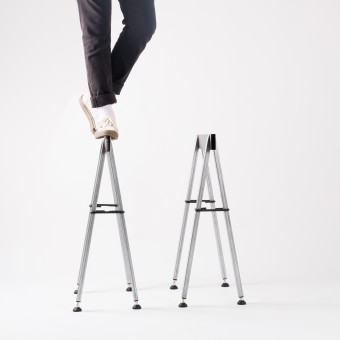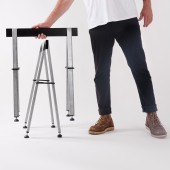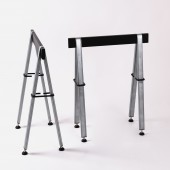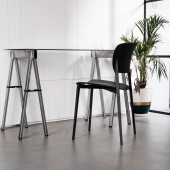DESIGN NAME:
Leika
PRIMARY FUNCTION:
Metal Trestles
INSPIRATION:
The design is derived from the ability to produce exceptionally simple designs using innovative technologies. The inspiration for the design came to me during a material experiment conducted with aluminum in a workshop at the university where I am studying. After visiting a laser tube-cutting factory, I realized that this technology could be effortlessly employed to fabricate highly durable industrial trestles.
UNIQUE PROPERTIES / PROJECT DESCRIPTION:
Simplicity- By utilizing laser profile cutting technology, the simple industrial profile is weakened to the point of bending. Following that, a complete round profile is enclosed under pressure, securely locking the trestles in a geometric lock.
OPERATION / FLOW / INTERACTION:
The product was created to embody simplicity in both manufacturing and assembly. Assembling the trestles is easily, quickly, and efficiently accomplished, accompanied by a distinct clicking sound that signifies the trestles are locked. The legs are adjustable to uphold the principles of universality and adaptability to any possible surface, while the chosen material is a simple industrial metal, ensuring the product's longevity.
PROJECT DURATION AND LOCATION:
The project started in January 2023 and will end in March 2023.
The project was presented as part of an exhibition of the Holon Institute of Technology and at the Shelush Gallery in Tel Aviv.
FITS BEST INTO CATEGORY:
Furniture Design
|
PRODUCTION / REALIZATION TECHNOLOGY:
3D cutting of steel profiles
Bending
Milling
SPECIFICATIONS / TECHNICAL PROPERTIES:
W600mmXD550mmXH710mm
The product can be shipped flat-packed.
Easy assembly with no screws, utilizing a geometric lock.
TAGS:
Trestles, Simple design, minimalistic, clean, simple, Generation Z machine-age, modern machine-age
RESEARCH ABSTRACT:
The research process commenced by studying various methods employed in metal product manufacturing and exploring different metal types. Ten different factories were visited to observe production techniques, including laser cutting, bending, erosion, castings, burning, extrusion, and blowing, among others. Following the initial research, the workshop dedicated to metal material research was utilized. The researcher's background as a civil engineer greatly facilitated the understanding that the material of choice would be simple galvanized metal. A series of bends were performed, providing rapid insights into the metal's flexibility and strength.
The research proceeded with user research to evaluate the product's market demand. Approximately 200 respondents from diverse age groups participated in the research, leading to the realization that there is indeed a market and a need for the product. This realization propelled the researcher to advance in technological research.
The chosen technology for the project was 3D cutting of profiles, selected due to its ability to produce a large quantity of profiles at a low cost through a simple cutting process, thereby enabling rapid production of finished products.
A functional initial prototype was developed, which underwent further user research to gain an understanding of the user's perspective. Twenty users were given the opportunity to assemble the prototype themselves. The assembly initially involved bending the metal and securing the profile onto the connecting profile. Based on the user research findings, it was concluded that the laser-cut profile should be pre-bent, as the average user lacks the necessary technical skills for bending without assistance.
The research concluded with a presentation at the researcher's educational institution, where industrial design professors with extensive experience provided critique and feedback.
CHALLENGE:
The most challenging aspect for the researcher involved the material research. Initially, aluminum was the preferred material due to its desired lightweight properties. However, when subjected to bending, it exhibited incorrect behavior and proved to be highly brittle. This setback initially dampened the researcher's enthusiasm for the project. However, further research shed light on the fact that weight reduction was not a crucial factor for the product's success. Additionally, it was discovered that the chosen technology, laser cutting, resulted in a slight distortion of the aluminum profiles due to the high heat involved.
ADDED DATE:
2023-04-27 12:29:22
TEAM MEMBERS (1) :
IMAGE CREDITS:
Photographer: Nimrod Shani
|









